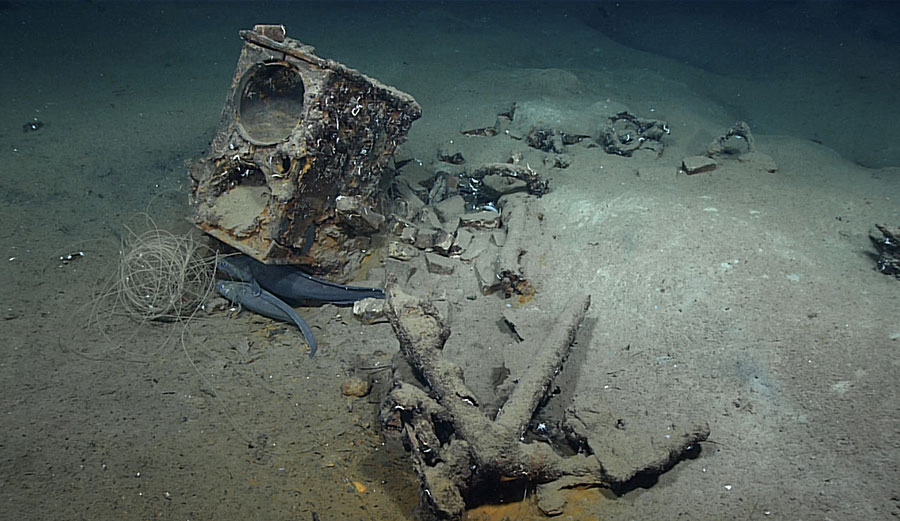186-Year-Old Shipwreck Discovered 6,000 Feet Down in the Gulf of Mexico

The whaling bring Industry was lost at sea in 1836. Now, it’s been found. Image: NOAA
On May 26, 1836, a whaling vessel called Industry ran into a powerful storm in the Gulf of Mexico. The storm snapped Industry‘s masts and opened up a gaping hole in its hull. The ship sank 6,000 feet to the bottom of the Gulf, doomed to be lost to the passage of time. But now, 186 years later, it’s been found.
The National Oceanic and Atmospheric Association announced the discovery on March 23, saying that “the remains of the 64-foot long, two-masted wooden brig opens a window into a little known chapter of American history when descendants of African enslaved people and Native Americans served as essential crew in one of the nation’s oldest industries.”
This feature is only available on TheInertia+
The Inertia+ offers exclusive access to The Inertia's original, premium features, reporting, films, members-only newsletters, discounted access to Inspire Courses, premium events, and special discounts from our partners.
*Billed annually. Join The Inertia+ for the price of an oat milk latte a month.
Working alongside a team of scientists led by James Delgado, Ph.D., senior vice president of SEARCH Inc., Scott Sorset, marine archeologist for the U.S. Bureau of Ocean Energy Management (BOEM), and Michael Brennan, Ph.D., also of SEARCH Inc., they were able to confirm that the wreck is most likely the brig Industry.
“Black and Native American history is American history, and this critical discovery serves as an important reminder of the vast contributions Black and Native Americans have made to our country,” said U.S. Deputy Secretary of Commerce Don Graves. “This 19th century whaling ship will help us learn about the lives of the Black and Native American mariners and their communities, as well as the immense challenges they faced on land and at sea.”
The Industry was built in Westport, Massachusetts in 1815. For two decades, it hunted whales across the Atlantic, Caribbean, and the Gulf of Mexico. Used primarily for hunting sperm whales, it sank 70 miles from the mouth of the Mississippi.
There was a bit of a mystery surrounding what exactly happened o the crew, but a librarian at the Westport Free Public Library named Robin Winters took it upon herself to solve it. She was able to find a newspaper article from June 17, 1836 article in the Nantucket Inquirer and Mirror that reported the Industry’s crew was picked up by another whaling brig, Elizabeth, and returned safely to shore back in Westport.
“This was so fortunate for the men onboard,” said James Delgado, Ph.D., who led the team of scientists and worked closely with Winters and several other local historians to confirm the identity of Industry. “If the Black crewmen had tried to go ashore, they would have been jailed under local laws. And if they could not pay for their keep while in prison, they would have been sold into slavery.”
The vessel was found after an energy company exploring the seafloor in 2011 spotted what looked to be a wreck. An autonomous vehicle spotted it again in 2017, but until February 25, 2022, it wasn’t fully explored. A team aboard the NOAA Ship Okeanos Explorer used an ROV to scope things out, and the images it captured are spectacularly clear.
One, for example, shows a piece of equipment called the tryworks, which was used to render whale blubber into oil. Made from cast iron, it’s basically a stove with a pair of large kettles.

This image of the tryworks was taken from the shipwreck site of brig Industry by a NOAA ROV. The tryworks was a cast iron stove with two deep kettles used to render whale blubber into oil. It was manufactured by G & W Ashbridge, a Philadelphia company. Photo: NOAA Ocean Exploration
The site of the shipwreck will be nominated for a spot in the National Register of Historic Places by SEARCH Inc and BOEM, the latter of which is heading up a project to document historic 19th century shipwrecks in the Gulf of Mexico.
“BOEM is proud to be a part of this important discovery,” said BOEM Director Amanda Lefton. “We work hard with our partners to safeguard historic and cultural treasures in the outer continental shelf.”
Newsletter
Only the best. We promise.
Related Posts
By accepting you will be accessing a service provided by a third-party external to https://oc3anclub.com/

